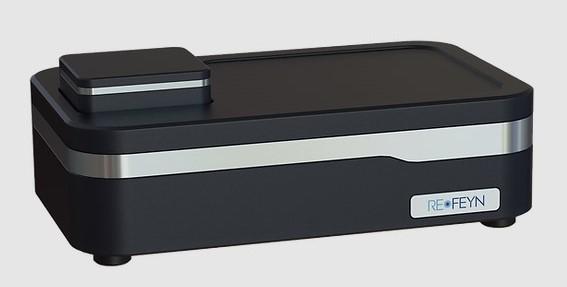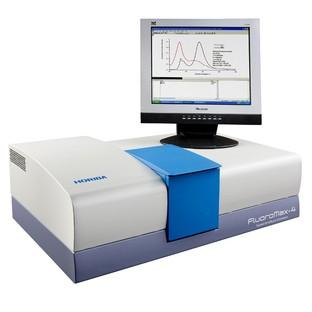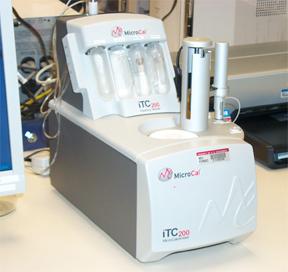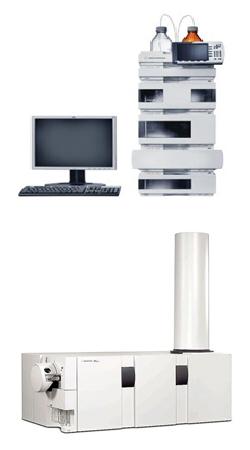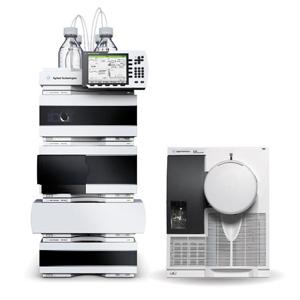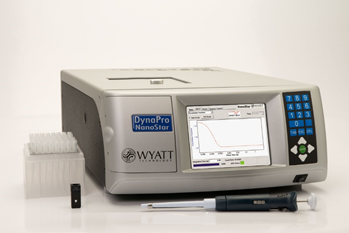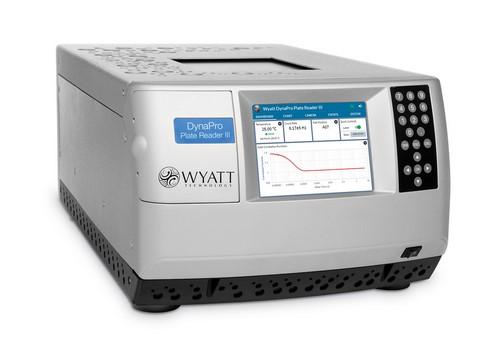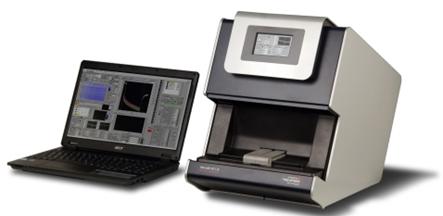Instrument: Refeyn TwoMP (Refeyn)
Applications:
- Mass measurement of single molecules in solution in their native state
- Determination of heterogeneity, aggregation status
- Macromolecular interactions
Major specifications:
- Mass range: 30 kDa – 5 mDa
- Mass precision: ± 2%
- Sensitivity: less than 1 ng of protein
- Concentration range: 100 pM – 100 nM
Probe:
- several microliters
Time for one analysis: as low as 4 - 5 minutes
Instrument: J-1500 CD Spectrophotometer (Jasco)
Applications:
- Conformational analysis of biomolecules
- Protein thermal stability
- Binding studies
Major Specifications:
- Range: 163-950 nm
- Light source: Xe 150W, supracil, air-cooled lamp
- Wavelength accuracy: 0.1 nm at 163-250 nm
- Scan modes: continuous scan, step-scan, auto-scan
- RMS noice: less than 0.004 mdeg at 185 nm
- Temperature regulation: –30 to +130° C
Probe:
- Concentration: ~ 0.1-1 mg/mL
- Cuvette volume: 2-4000 µL
- Path length: 0.001-10 mm
Time for 1 analysis (spectrum): as low as 0.33 min.
Instrument: Single Photon Counting Spectrofluorometer FluoroMax-4C (HORIBA Instruments)
Applications:
- Macromolecular binding
- Conformation data (based on environmental sensitivity, polarization, energy transfer, quenching studies, etc.)
- Protein folding
Major Specifications:
- Range: 200-950 nm (excitation and emission)
- Light source: 150-watt Xenon arc lamp
- Wavelength accuracy: 0.5 nm
- Scan speed: up to 200 nm/sec
- Water Raman signal-to-noise ratio: 3000:1
- Temperature regulation: Peltier-based, -40 to +110°C
- Integration time: 1 ms - 160 s
- Sensitivity dynamic range: 6 orders of magnitude in the same spectrum
- Polarization: automated
Probe:
- Cuvette volume: 30-4000 µL
- Path length: 1-10 mm
- Concentration: < 1 µM
Time for 1 analysis (spectrum): 1-5 min.
TCSPC (Time-Correlated Single Photon counting) unit: lifetime range from 25 ps to 10 s.
Instrument: iTC200 Isothermal Titration Calorimeter (Malvern - MicroCal)
Applications:
- Complete characterization of the molecular interactions of small molecules, proteins, antibodies, nucleic acids, lipids and other biomolecules in a single titration experiment
- Enzyme kinetics
- Assessment of the effect of molecular structure changes on binding mechanisms
Major Specifications:
- Direct measurement of sub-millimolar to nanomolar binding constants
- Temperature range: 2 to 80°C
- Cell/cell compensation: power feedback
- Response time: 10 seconds
Probe:
- Cell: at least 2 µM of biomacromolecule in 200 µL of buffer solution
- Syringe: 10 times more concentrated ligand in 40 µL of the same buffer
Time for 1 analysis: as low as 0.5 hour, typically – 1 hour
Instrument: 6520 Accurate-Mass Quadrupole Time-of-Flight (Q-TOF) LC/MS/MS (Agilent Technologies, Inc.)
Applications:
- Identification, characterization, structure confirmation and profiling of samples as diverse as small molecules, metabolites, peptides, proteins, oligonucleotides, etc.
Major Specifications:
- Typical mass accuracy: 1 ppm MS and 2 ppm MS/MS
- Enhanced mass resolution: up to 20,000 resolving power
- Ion source modes: Dual-spray electrospray ionization (ESI) source
- Multimode source: ESI/APCI (atmospheric pressure chemical ionization)
- In-spectrum dynamic range: up to 5 orders
- Sensitivity: high-attomole to low-femtomole
- Spectral acquisition rates: up to 20 MS or 10 MS/MS spectra per second
- Time-of-flight mass range: m/z 20–20,000
Instrument: 6100 Series Single Quadrupole LC/MS (Agilent Technologies, Inc.)
Applications:
- Molecular weight and structure characterization
Major Specifications:
- Mass range: m/z 10-3000
- Mode: API-electrospray or Multimode (ESI/APCI)F
- Mass accuracy: 0.13 Da within the calibrated mass range in scan mode
- Mass axis stability: 0.13 Da over 8 hours
- Sensitivity: for 1 pg reserpine RMS 100:1
- Analyte polarity: from intermediate non-polar to highly polar
- Multiple signal acquisition: ability to cycle through four different acquisition modes
Time for 1 analysis (spectrum): 5-40 min
Instruments: DynaPro NanoStar and DynaPro Plate Reader III Dynamic Light Scattering (Wyatt Technologies)
Instrument: DynaPro NanoStar Dynamic Light Scattering instrument (Wyatt Technologies)
Applications:
- Characterization of protein size and size distribution, weight-average molecular weight and thermal stability of biomacromolecules
- Screening samples for self-association over a broad range of solutions and conditions
- Measurement of stability and size of lipids, conjugates, nanoparticles and other drug delivery particles
Major Specifications:
- Laser wavelength: 658 nm
- Scattering angle: 90°
- Temperature range: -15 to 150° C
- Size range (radius): 0.2-2500 nm
- Static Scattering Molecular Weight Range: 300 Da to 1 MDa (sample dependent – maximum molecular radius 12 nm)
Probe:
- minimum concentration: 0.1 mg/ml (14 kDa lysozyme in PBS, 100 s acquisition)
- minimum sample volume: 1.25 μL
Time for 1 analysis: 5-30 min.
Instrument: DynaPro Plate Reader III Dynamic Light Scattering instrument (Wyatt Technologies)
Applications:
- High-throughput screening and other automated measurements of multiple samples
- Characterization of protein size and size distribution, weight-average molecular weight and thermal stability of biomacromolecules
- Screening samples for self-association over a broad range of solutions and conditions
Major Specifications:
- Laser wavelength: 830 nm
- Temperature range: 4 to 85° C
- Size range (radius): 0.5-1000 nm
- Static Scattering Molecular Weight Range: 1000 Da to 1 MDa (sample dependent – maximum molecular radius 12 nm)
Probe:
- minimum concentration: 0.125 mg/ml (14 kDa lysozyme)
- minimum sample volume: 20 μL (in Corning 384 well plates)
Plate Scan Time: As little as 1.5h for 384 well plate
Instruments: Monolith NT.115 G009 and Monolith Pico RED/BLUE (NanoTemper Technologies GmbH)
Instrument: Monolith NT.115 G009 (NanoTemper Technologies GmbH)
Applications:
- Immobilization-free biomolecular binding
Major Specifications:
- LED light sources: a) BLUEexcitation wavelength: 470 nm; b) RED excitation wavelength: 625 nm
- IR-laser: wavelength 1475+/- 15 nm; power 120 mW max.
- Temperature control: 20 to 37°C, accuracy +/- 0.3°C
- KD range: 1 nM – 500 mM
- Molecular weight range: 101–107 Daltons
Probe:
- One of binding partners should be labeled with a fluorescent dye
- The experimental set: 12 – 16 glass capillaries with premixed assay solutions
- Capillary volume: 5 μL
- Concentration of the labeled compound: close to expected KD value or lower.
Time for 1 analysis: around 15 min.

Instrument: Monolith Pico RED/BLUE (NanoTemper Technologies GmbH)
Applications:
- Immobilization-free biomolecular binding
Major Specifications:
- LED light sources: a) Pico RED excitation wavelength: 600-650 nm; b) BLUE excitation wavelength: 460-490 nm
- IR-laser: wavelength 1475+/- 15 nm; power 120 mW max.
- Temperature control: 20 to 40°C, accuracy +/- 0.5°C
- KD range: 1 pM to mM (RED), 1nM to mM (BLUE)
- Molecular weight range: 101–107 Daltons
Probe:
- One of binding partners should be labeled with a fluorescent dye
- The experimental set: 12 – 24 glass capillaries with premixed assay solutions
- Capillary volume: 5 μL
- Concentration of the labeled compound: close to expected KD value or lower.
Time for 1 analysis: around 10 min.
Instrument: Prometheus NT.48 (PR001) with Back-reflection Optics (NanoTemper Technologies GmbH)
Applications:
- Ultra-high resolution protein stability and aggregation
Major Specifications:
- Light source: LED with excitation wavelength 285 nm
- Fluorescence detection: 330 and 350 nm
- Native DSF: no dye is required; tyrosine and tryptophan fluorescence is analyzed
- Temperature range: from 15 °C to 95 °C
- Run-by-run reproducibility of experiments in thermal ramp of 1 °C/min: +/- 0.01 °C (at 65 °C)
- High throughput: 48 samples at a time
Probe:
- Protein concentration range: 5 μg/ml to 250 mg/ml (standard IgG)
- Sample volume: 10 μL
Time for 1 analysis (assay): 1-2.5 hours
Instrument: UV/Vis Photodiode Array Spectrophotometer Lambda 465 (PerkinElmer) with thermal scanning option
Applications:
- Characterization of absorbance of light by biomolecules in solution in ultraviolet and visible region of spectra
- Quantification of nucleic acids, proteins and other biomolecules
- DNA denaturation studies
- Enzyme kinetics
Major Specifications:
- Wavelength range: 190-1100 nm
- Absorbance range: ± 3 A
- Bandwidth: 1 nm
- Wavelength accuracy: - ± 0.2 nm
- Wavelength reproducibility: < 0.02 nm
- Photometric accuracy: ± 0.005 A
- Photometric reproducibility: < 0.001 A
- Photometric drift: < 0.001 A/hour
- Time for full spectra acquisition: 20 msec
- Source: deuterium and tungsten lamps
Temperature control:
- Multi Peltier Temperature Control Unit, accommodating for up to 8 samples for automated measurement
- Temperature control range: -10 to 100° C
- Temperature accuracy: ± 0.15° C
- Temperature control precision: 0.1° C
Probe:
- minimum sample volume: 2 μL
Software: UV Lab; UV Lab Bio Analysis; UV Lab Ultra Kinetics
Instrument: DRX2 Analyzer (Dynamic Biosensors GmbH)
Applications:
- Multi-parameter biophysical analysis of molecular interactions, sizing, thermodynamics
Major Specifications:
- Limit of detection – 10 fM
- Dissociation constant 50 fM – 1 mM
- Association rate constant 1E3 – 1 E8/Ms
- Dissociation rate constant 1E-6 – 1E0/s
- Hydrodynamic diameter accuracy of 0.1 nm
- Temperature control: 8 to 75°C (chip), 10 to 40°C (autosampler)
- Dual-color option: analysis of two molecular probes on the same detection spot
Probe:
- Multiply-usage biochips contain 20 microelectrodes, arranged in 4 separate flow channels
- Microelectrode surfaces are supplied with electrically switchable DNA nanolevers
- Nanolevers are functionalized by conjugation with molecules of interest
- Typical amounts of binding partners – variable, tentatively 10-300 µL of 500-10 nM solutions
Time for 1 analysis (assay): around 2 – 4 hours.
